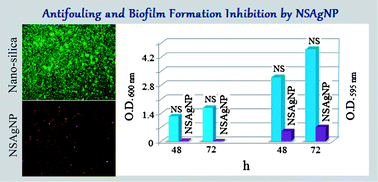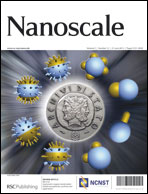A nano-silica–AgNPs composite material is proposed as a novel antifouling adsorbent for cost-effective and ecofriendly water purification. Fabrication of well-dispersed AgNPs on the nano-silica surface, designated as NSAgNP, has been achieved through protein mediated reduction of silver ions at ambient temperature for development of sustainable nanotechnology. The coated proteins on AgNPs led to the formation of stable NSAgNP and protected the AgNPs from oxidation and other ions commonly present in water. The NSAgNP exhibited excellent dye adsorption capacity both in single and multicomponent systems, and demonstrated satisfactory tolerance against variations in pH and dye concentration. The adsorption mainly occurred through electrostatic interaction, though π–π interaction and pore diffusion also contributed to the process. Moreover, the NSAgNP showed long-term antibacterial activity against both planktonic cells and biofilms of Gram-negative Escherichia coli and Pseudomonas aeruginosa. The antibacterial activity of AgNPs retarded the initial attachment of bacteria on NSAgNP and thus significantly improved the antifouling properties of the nanomaterial, which further inhibited biofilm formation. Scanning electron and fluorescence microscopic studies revealed that cell death occurred due to irreversible damage of the cell membrane upon electrostatic interaction of positively charged NSAgNP with the negatively charged bacterial cell membrane. The high adsorption capacity, reusability, good tolerance, removal of multicomponent dyes and E. coli from the simulated contaminated water and antifouling properties of NSAgNP will provide new opportunities to develop cost-effective and ecofriendly water purification processes.

You have access to this article
 Please wait while we load your content...
Something went wrong. Try again?
Please wait while we load your content...
Something went wrong. Try again?


 Please wait while we load your content...
Please wait while we load your content...